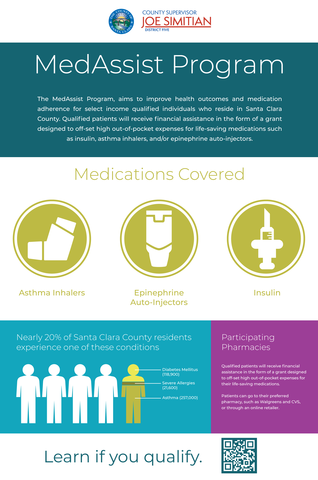MedAssist: Helping the “Missing Middle” Afford Essential Medication
Insulin, inhalers, and EpiPens are not indulgences. In Santa Clara County, we have 118,900 adults who have been diagnosed with diabetes, 257,000 adults and children with asthma, and 21,600 individuals who are prescribed epinephrine auto-injectors for allergic reactions.
These medications are essential for their survival. They also cost a lot more than they used to.
A lot.
Twenty years ago, a one-month supply of insulin cost about $21. Today it’s $275. The cost for one asthma inhaler jumped more than 50% in the past five years, from the unreasonable—$316—to the outrageous: $496.
You read that right: almost $500 for one inhaler. The reasons for the stratospheric rise in prescription drug costs may be complex, but the bottom line is that it’s hurting too many people.
Diabetes, asthma, and severe allergies are chronic, lifelong, and common conditions that can be well managed with proper treatment. No one should have to break the bank in order to afford that treatment—or go without, with potentially catastrophic consequences.
That’s why I led the County’s effort to create and launch MedAssist, a new program that covers the cost of life-saving medications for qualifying residents with these conditions.
MedAssist is purposely designed for the many folks in our community who fall into the “missing middle,” with an income that’s just high enough that they don’t qualify for health care subsidies, and often must pay high out-of-pocket costs for medications. Even when drugs are “covered” by health insurance, they may not be affordable.
As one local resident recounted, her co-pay through Covered California for a one-month supply of insulin was $55—far less than the out-of-pocket price—but it was money she simply didn’t have after losing her job during the pandemic.
“The application process for MedAssist was easy,” she said. Within weeks of applying, she started receiving a monthly check to cover nearly the full cost of her insulin. “Financially, I am really thankful I get this help.”
MedAssist is administered through the Santa Clara Valley Medical Center, but grant recipients don’t have to be a member of the County health system or fill prescriptions at a County pharmacy. The program’s eligibility criteria are brief and straightforward:
- 18 years or older;
- Live in Santa Clara County;
- Have a valid prescription for an asthma inhaler, insulin, or epinephrine auto-injector;
- Meet annual gross income requirements, set on a sliding scale for households of 1 to 8 people (e.g., below $251,486 for a family of four).
“Patients suffering from chronic diseases have a particularly difficult time, not only because of their disease state but because of the rising cost of their medications,” VMC Pharmacy Director Narinder Singh told me. “Due to financial limitations, some patients may miss their medications to make ends meet.”
In fact, a 2019 study in the Journal of the American Medical Association noted that as many as one in four people with diabetes were cutting back on their insulin doses or skipping them altogether to save money. Over time, inadequate medication can lead to complications like blindness, heart disease, lower leg amputations—or worse.
As Dr. Singh puts it: “These vital medications can be the difference between life and death.”
If MedAssist can help you, please apply soon—and share this information with anyone you know who might benefit. Funding is limited for each program year, and the application deadline for 2021-2022 grants is May 31 (or until funding is exhausted). Applications open June 1 for the 2022-2023 program year, which starts July 1. Apply online at https://health.santaclaracounty.gov/medassist; or, paper applications are available from any County health outpatient pharmacy. There’s also help available by phone at (408) 970-2001.
In addition to the obvious public health benefits, MedAssist will to some degree pay for itself. Emergency room visits are one of the leading reasons for high health care costs in the County. People go to the ER when they have nowhere else to go. Providing local residents with access to the medications they need to survive is one way we can both cut costs and save lives. It’s a case where an ounce of prevention truly is worth a pound of cure.
Joe Simitian
Santa Clara County Board of Supervisors
This article was originally published in the Saratoga Spotlight in March 2022.
